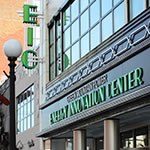 Green Mountain Power’s $2.75 million renovation of a 7,000-square-foot, circa-1925 department store demonstrates a commitment to sustainable design, renewable energy, and community revitalization. “Many of our customers want to use solar power, and we’ve incorporated that into our business model by trying to develop a more concierge-style approach to providing energy,” says Steve Costello, the company’s vice president of generation and energy innovation. GMP supplies 75 percent of Vermont’s electricity, and its LEED Gold Energy Innovation Center, set to open November 2014, reflects that mission, housing an array of sustainable features, public exhibits on energy, offices for 30 GMP employees, and space for nonprofits Efficiency Vermont and NeighborWorks of Western Vermont. Costello takes us on a tour.
Green Mountain Power’s $2.75 million renovation of a 7,000-square-foot, circa-1925 department store demonstrates a commitment to sustainable design, renewable energy, and community revitalization. “Many of our customers want to use solar power, and we’ve incorporated that into our business model by trying to develop a more concierge-style approach to providing energy,” says Steve Costello, the company’s vice president of generation and energy innovation. GMP supplies 75 percent of Vermont’s electricity, and its LEED Gold Energy Innovation Center, set to open November 2014, reflects that mission, housing an array of sustainable features, public exhibits on energy, offices for 30 GMP employees, and space for nonprofits Efficiency Vermont and NeighborWorks of Western Vermont. Costello takes us on a tour.
Maximum Impact
Once one of the largest manufacturing hubs in Vermont—shipping slate, granite, and precision-weighing devices worldwide—downtown Rutland is now largely vacant. The Eastman Building, neglected for nearly a decade, had flooded at least three times and had been subjected to four feet of water and raw sewage in its basement. “None of the damage was ever remediated,” Costello says. “There was mold, asbestos, fire damage, trees growing through the roof—you name it. But when we looked at every available building and lot, this was the perfect fit. We could also have the most impact on the city by restoring it.” Restoration efforts included preserving historical elements like the metal ceiling and terra cotta façade and design improvements to improve drainage.
Sum of Two Parts
The original Eastman Building is Art Deco in design but linked with a smaller, wooden clapboard structure. GMP’s team hired a local company to reface the wooden building in a stucco-like finish, adding several raised aluminum accent pieces for an Art Deco feel. “We created a mini version of the larger building,” Costello says. The building boasts Rutland’s first revolving door, adding visual interest and increasing energy efficiency by 30 percent. Natural lighting comes from large skylights over the exhibit areas and light tubes that draw it from collectors on the roof. “The lights are all on sensors, but the building is so bright during the day that the bathroom lights almost never switch on,” Costello says.
Energy Education
Twelve exhibits educate school groups and the public about renewable energy sources like hydro, wind, and solar power and how each contributes to the electrical grid. Kids can learn about the nature of cause and effect by jumping on a floor panel, creating energy to power up a light display. A seven-foot-long animatronic cow named Electra illustrates how electricity is generated from manure produced by area farms. On the rooftop, visitors can view the building’s two solar arrays, a miniature wind turbine, and heat pumps. The building is part of the energy exhibit, showcasing efficiency in a real setting. “Our goal is to burn no fossil fuels to heat this space,” Costello says.
Creative Heating
Although air-source heat pumps are fairly common in warmer climates, GMP wanted to demonstrate its ability to warm the built environment even during Vermont’s chilly winters. “The first winter we were open, we burned about 40 gallons of oil,” Costello says. “The heat only came on for two days. We’ve proven that in a huge space with good insulation, this type of heat can work in a cold climate.” Heat socks—blue fabric tubes on the ceiling—direct the heat throughout the large space and provide even heat regardless of drastic changes in exterior temperatures. The system is working so well that GMP is piloting a program to install air-source heat-pump systems in 150 customers’ homes.

